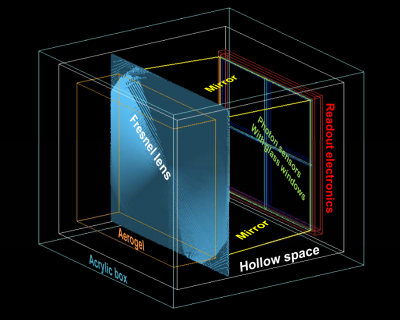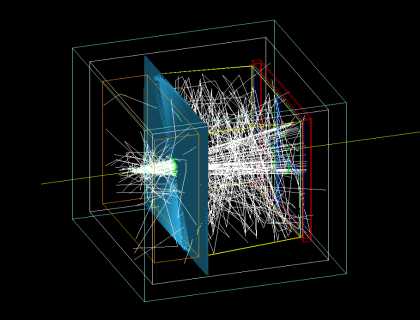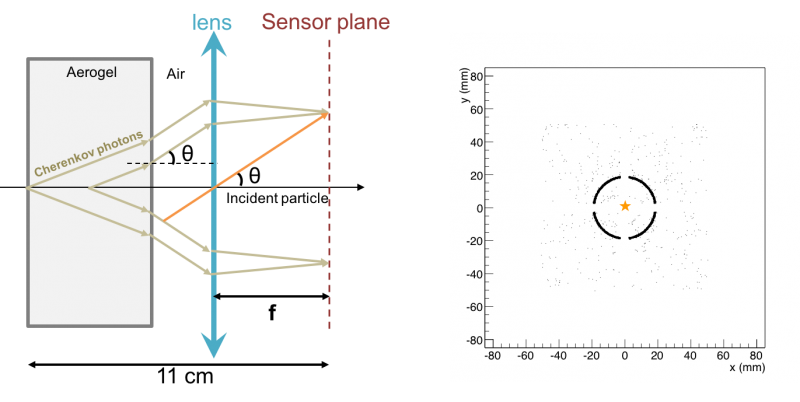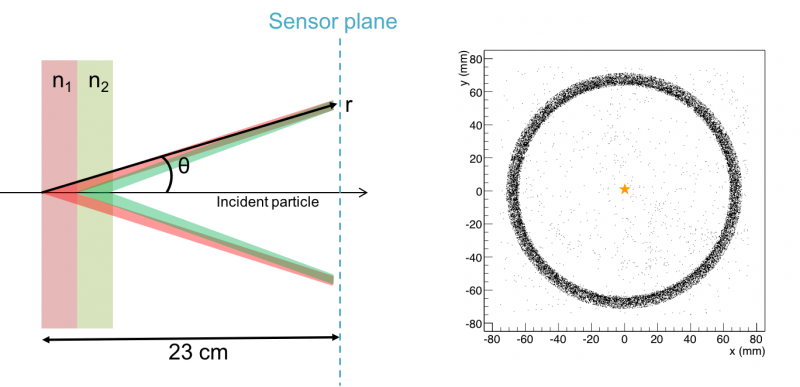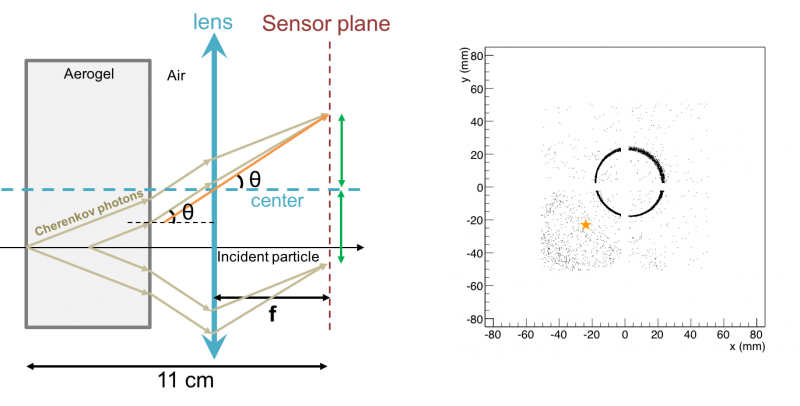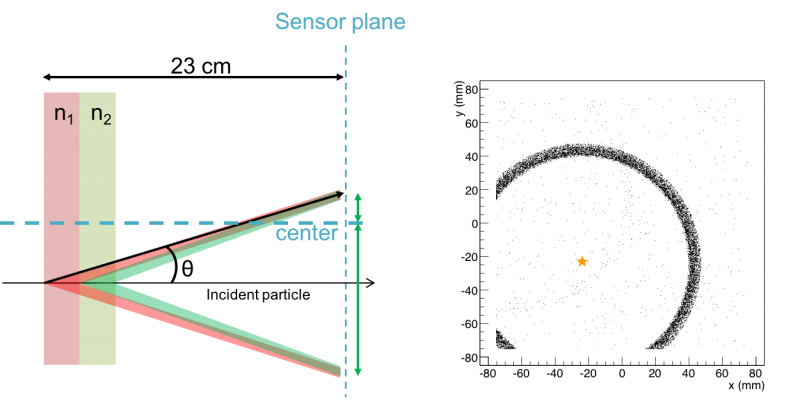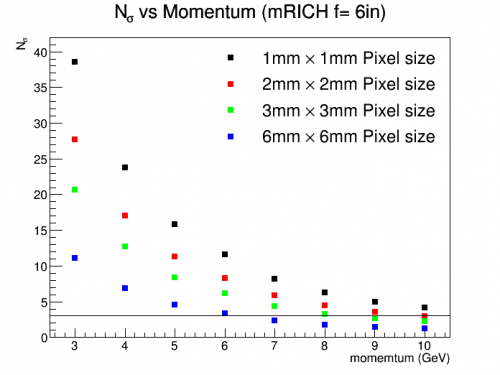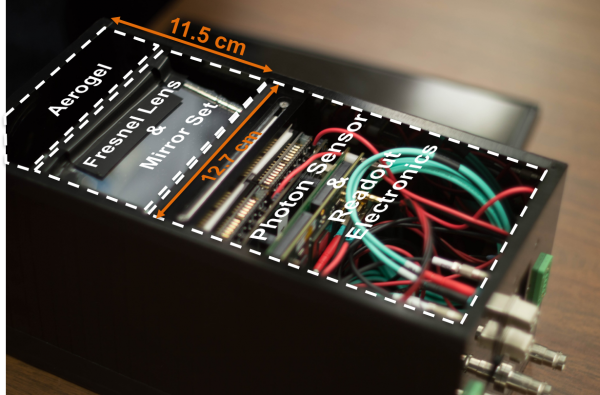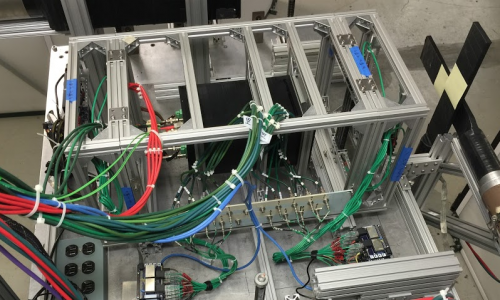Difference between revisions of "Modular Ring Imaging Cherenkov Detector (mRICH)"
(→Detector Design) |
|||
| Line 11: | Line 11: | ||
| [[image:Detector overview 9GeVPi center.png|left|420px|Single 9 GeV/c pion simulation]] | | [[image:Detector overview 9GeVPi center.png|left|420px|Single 9 GeV/c pion simulation]] | ||
|- | |- | ||
| − | | Modular RICH detector in GEMC simulation | + | | Figure 1.1. Modular RICH detector in GEMC simulation |
| − | | Single 9 GeV/c pion simulation | + | | Figure 1.2. Single 9 GeV/c pion simulation |
|} | |} | ||
| Line 19: | Line 19: | ||
| [[image: LensFocusing withLens.png |left|800px]] | | [[image: LensFocusing withLens.png |left|800px]] | ||
|- | |- | ||
| − | | Lens focusing gives thinner Cherenkov ring image compare to BELLE-2 ARICH design (below) | + | | Figure 1.3. Lens focusing gives thinner Cherenkov ring image compare to BELLE-2 ARICH design (below) |
|- | |- | ||
| [[image: BELLE2 ARICH Focusing.png |left|800px]] | | [[image: BELLE2 ARICH Focusing.png |left|800px]] | ||
|- | |- | ||
| − | | BELL-2 ARICH design a double layer proximity focusing RICH detector. By using two different refractive indices aerogel block, in order to increase number of photons detected while keeping uncertainty of single photon measurement. | + | | Figure 1.4. BELL-2 ARICH design a double layer proximity focusing RICH detector. By using two different refractive indices aerogel block, in order to increase number of photons detected while keeping uncertainty of single photon measurement. |
|} | |} | ||
| Line 30: | Line 30: | ||
| [[image:LensShifting withLens.png |left|800px]] | | [[image:LensShifting withLens.png |left|800px]] | ||
|- | |- | ||
| − | | When the charge particle incident along the z-axis of the detector, Cherenkov ring image from the incident particle will be shifted to the central area of the sensor plane, resulting fewer photon loss, and reduce image distortion. | + | | Figure 1.5. When the charge particle incident along the z-axis of the detector, Cherenkov ring image from the incident particle will be shifted to the central area of the sensor plane, resulting fewer photon loss, and reduce image distortion. |
|- | |- | ||
| [[image: BELLE2 ARICH Shifting.png |left|800px]] | | [[image: BELLE2 ARICH Shifting.png |left|800px]] | ||
|- | |- | ||
| − | | Cherenkov ring image from particles that are incident at the third quadrant of the detector. | + | | Figure 1.6. Cherenkov ring image from particles that are incident at the third quadrant of the detector. |
|} | |} | ||
| Line 41: | Line 41: | ||
| [[image:Num sigma 6inFocalLength.png|left|500px]] | | [[image:Num sigma 6inFocalLength.png|left|500px]] | ||
|- | |- | ||
| − | |Separation power of modular RICH detector obtained from simulation using 6" focal length Fresnel lens with different pixel sizes | + | | Figure 1.7. Separation power of modular RICH detector obtained from simulation using 6" focal length Fresnel lens with different pixel sizes |
|} | |} | ||
Revision as of 15:49, 25 January 2017
The modular aerogel RICH is designed for hadron identification covering a momentum range of 3-10 GeV/c. Silica aerogel has been used for decades in threshold Cherenkov counters for high energy physics experiment and has recently been used as radiator material for RICH detectors for the HERMES, LHCb, AMS, Belle experiments, and for the CLAS12 experiment. This R&D has been benefiting from having in house expertise acquired from CLAS12 RICH. The optical properties of aerogel are crucial parameters for the performance of mRICH. For instance, any angular dispersion of the emitted photons affects the precision of the Cherenkov angle measurements. In addition, a high transparency (transmittance) and a proper refractive index are required in order to collect a sufficient number of photons for a reliable ring reconstruction. The design features of the mRICH are shown in Figure 2.3.1. The main components of the modular design include: (a) the aerogel block at the front (characteristic dimension: 10cm x 10cm x 3cm and n = 1.01 - 1.05), (b) focusing Fresnel lens (for projecting Cherenkov ring image toward the central region of the photon sensor plane), (c) high quality mirror set on the side walls, and (d) the photon sensor plane. The focus of this particular R&D is to systematically study the mRICH performance through simulation with realistic material properties of the aerogel block, Fresnel lens and mirror configuration (i.e. tilting angle) and to verify the simulation results through prototyping and beam test. The performance of the mRICH in the EIC detector will also been studied.
Detector Design
| Figure 1.1. Modular RICH detector in GEMC simulation | Figure 1.2. Single 9 GeV/c pion simulation |
| Figure 1.3. Lens focusing gives thinner Cherenkov ring image compare to BELLE-2 ARICH design (below) |
| Figure 1.4. BELL-2 ARICH design a double layer proximity focusing RICH detector. By using two different refractive indices aerogel block, in order to increase number of photons detected while keeping uncertainty of single photon measurement. |
| Figure 1.5. When the charge particle incident along the z-axis of the detector, Cherenkov ring image from the incident particle will be shifted to the central area of the sensor plane, resulting fewer photon loss, and reduce image distortion. |
| Figure 1.6. Cherenkov ring image from particles that are incident at the third quadrant of the detector. |
| Figure 1.7. Separation power of modular RICH detector obtained from simulation using 6" focal length Fresnel lens with different pixel sizes |
Fisrt Prototype
| First mRICH prototype |
| Component | Function | Specification |
|---|---|---|
| Detector holder box | provide light tight enviroment | acrylic |
| Aerogel | radiator | refractive index=1.03 |
| Fresnel lens | focus Cherenkov photons | spheric acrylic Fresnel lens. focal length=3" |
| Mirror set | ||
| Sensor | HAMAMATSU 8500 PMT array. Pixel size=6×6mm |
Beam Test
Beam test set up at Fermilab Test Beam Mtest Facility for the first modular RICH prototype detector is shown in the picture below. The detector (black box) sit at the center of a aluminium frame. On both ends of the aluminium frame are hodoscopes. Each hodoscopes consist of four horizon finger-size (1mm x 1mm) scintillators, and four vertical finger-size scintillators. On the far right of the aluminium frame is trigger paddle. The beam is coming from right to left of the picture.
| Beam test set-up at Fermilab Test Beam Mtest Facility for the first modular RICH prototype detector. |
